■THE BEGINNINGS OF THE SHAVER
Do you know when and by whom the electric shaver (electric razor) you use every morning was made?
■PACKARD LEKTRO SHAVER 
(The First Competitor to Schick Shaver)

The Packard Lectro Shaver is a brand that no longer exists. It is said to have continued until around 1953, but it is highlighted here as the "world's first competitor" shaver created to rival the Schick Shaver. The company was sued by Schick for "patent infringement," and the case took until 1939 to conclude, with the verdicts going back and forth.

The manufacturer and seller of the Packard Lectro Shaver was Dictograph Products, Inc. The company developed a flameless lighter called the Electro-Light Cigarette Lighter, and its publicity-loving president, Archie Moulton Andrews, used magazine ads featuring Hollywood actors to boost sales. This lighter remains a collector's item today due to its unique design.
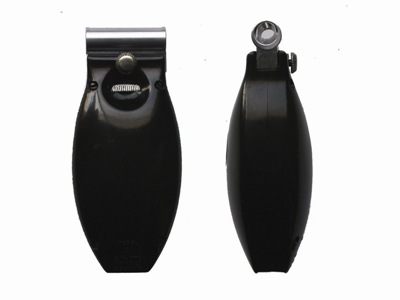
In 1934, at the Chicago World's Fair, Archie M. Andrews sold Schick Shavers alongside his Electro-Light Cigarette Lighter and negotiated with Jacob Schick for the rights to sell Schick Shavers in the Midwest. When Schick refused, Andrews became furious and decided to develop his own shaver to compete with Schick. He built a factory near Schick's in Stamford, Connecticut, and produced the shaver under the name "Packard Lectro Shaver."
A similar story involves Lamborghini, whose founder, angered by Ferrari's response, decided to create his own car to compete with Ferrari. While the Ferrari and Lamborghini story dates to 1962, Archie Moulton Andrews also had connections to the automotive industry.

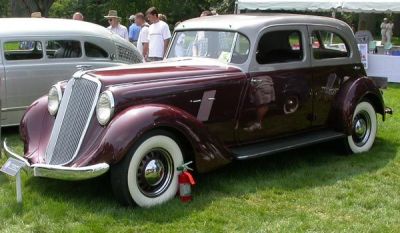
The lighter and shaver businesses were part of Dictograph Products, Inc., but Andrews briefly served as chairman of the Hupmobile Company.
He was ousted from the company after a campaign he started (where customers referred potential clients) led to legal trouble.
The Hupmobile Company was a mid-sized American manufacturer that produced cars under the model name Hupmobile from 1908 to 1941.
In 1940, they bought the molds for the Cord 810/812 and transplanted the rear-wheel-drive running gear (the Cord 810/812 was famous for its advanced front-wheel-drive design, and the company went bankrupt after producing these models).
Despite the modern design and affordable price, Hupmobile couldn't keep up with deliveries, and the company was eventually absorbed by other manufacturers.
The second photo shows the 1934 "Aerodynamic" model, a sedan designed by the popular designer Raymond Loewy. It featured a three-part front windshield, a slanted grille, and integrated headlights in the hood, embodying the streamlined design concept. Incidentally, the Hupmobile Company was the first company to commission car designs from Raymond Loewy after he came to America.
In 1940, Loewy also designed the successor to the Schick Shaver, with a streamlined design theme (details on this in the Schick section).
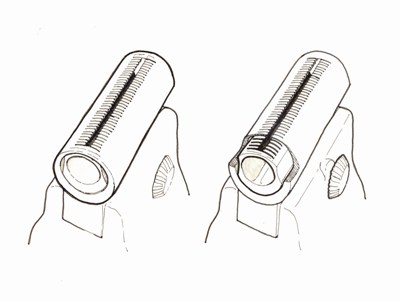
Model Details
As one might imagine from its origins, the Packard Lectro Shaver was sued by Schick for patent infringement upon its release. The court recognized the infringement, but Dictograph Products, Inc. appealed, and it took five years to reach a resolution.
The Packard Lectro Shaver featured cylindrical blades. Each side of the horizontal slit for hair introduction on the cylinder had 37 grooves.
The inner blade was also cylindrical and slid axially, "in contact" with the outer blade. The grooves on the outer blade were about 0.2mm wide, with 36 blades about 0.6mm wide. The inner blade's amplitude was only about 0.5mm, so it could only cut hair in one direction (forward stroke) through the 0.2mm grooves.

Additionally, the "eccentric pin" that converted the motor's rotation into the reciprocating motion of the blades was located at the extended end of the motor shaft. This structure limited the inner blade's amplitude to about 0.5mm.

On the other hand, the simple structure, with all major components like the "motor current switching contact," "starter flywheel," and "eccentric pin" housed on the motor shaft, likely provided significant cost advantages in competing with Schick's shavers.
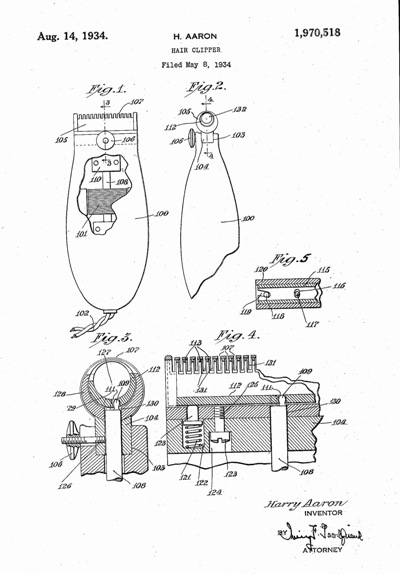
Patent Litigation
Dictograph Products, Inc. applied for a patent for the Packard Lectro Shaver in May 1934, claiming that the existing shaving heads (i.e., Schick's) could not reliably cut hair and that their cylindrical head improved these shortcomings.
Schick immediately sued for patent infringement. The court recognized the infringement, but Dictograph Products, Inc. appealed.
In 1937, the court ruled that Dictograph's patent did not infringe Schick's claims.
The proceedings continued, and in 1939, the previous ruling was overturned. Dictograph Products, Inc. withdrew their appeal, and the case was concluded with Schick's victory.
Dictograph Products, Inc. abandoned the patent itself in 1941.
The verdictin 1939 was a big news story at the time, and the New York Times published an article like the one below.
The two main figures, Jacob Schick and Archie M. Andrews, both passed away within less than a year of each other, without seeing this verdict.
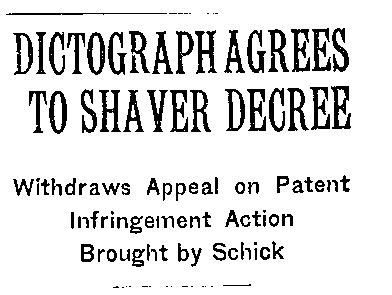
Article on the lawsuit settlement
This 1939 conclusion was significant news, with the New York Times publishing an article titled "DICTOGRAPH AGREE TO SHAVER DECREE" on September 26, 1939, highlighting the withdrawal of the appeal and the delayed ruling that led to many competitors entering the market. The article also noted that while Schick sold only 3,000 units when it first launched in 1930, it was expected to sell one million units in 1939, reflecting the growth of the shaver market.

Advertising
The most famous advertisement for the Packard Lectro Shaver featured a magazine ad with a photo of two children playfully shaving. This seems to be the only advertisement that appears when researching Packard Lectro Shaver ads, suggesting it was widely published. Schick's initial message when creating the electric razor was also about "safe use" without worrying about (razor) cuts, but Packard Lectro Shaver's ad took it to the next level by featuring children.
Packard Lectro Shaver constantly competed with Schick in price wars. For example, in 1938, Schick reduced its initial price of $15 to $12.50. Dictograph Products, Inc. immediately halved the price of the Packard Lectro Shaver from $15 to $7.50. This was significant news at the time, covered by TIME magazine. Incidentally, $15 at that time is equivalent to over $300 today.